Medical expert of the article
New publications
Preparations
Remedies for dry cough
Last reviewed: 04.07.2025

All iLive content is medically reviewed or fact checked to ensure as much factual accuracy as possible.
We have strict sourcing guidelines and only link to reputable media sites, academic research institutions and, whenever possible, medically peer reviewed studies. Note that the numbers in parentheses ([1], [2], etc.) are clickable links to these studies.
If you feel that any of our content is inaccurate, out-of-date, or otherwise questionable, please select it and press Ctrl + Enter.
Cough is one of the most unpleasant symptoms of many diseases, although many associate this symptom only with colds and flu. Despite the negative attitude towards it, cough, like fever, is actually a protective reaction of our body, which thus resists diseases. It turns out that fighting a cough means harming yourself? Yes, if the cough is productive, i.e. accompanied by the release of sputum containing infections, allergens, foreign bodies and other components, with which the irritation of the mucous membrane was associated. But there is another type of cough - unproductive, exhausting, taking away the body's strength to fight. The goal of treating such a symptom, depending on the situation, is to convert a dry cough into a productive one or suppress the cough reflex. This is exactly what remedies for dry cough, purchased in pharmacies or made according to traditional medicine recipes, are designed to do.
Dry cough and its treatment
There is no person in the world who would like to cough, even though coughing in many cases alleviates the patient's condition. And this is precisely what the physiologically conditioned protective reflex, to which we ourselves gave the name cough, is designed for.
Coughing occurs as a result of irritation of the mucous membrane of the respiratory tract, which is supplied with many nerve endings. A signal in the form of bioelectric impulses is sent along the nerve fibers to the cough center, located in the medulla oblongata near the base of the skull. By the way, the vomiting center is also located nearby, which causes the urge to vomit during a painful dry cough.
When receiving an "SOS" signal, the cough center engages the muscles of various organs of the respiratory system, but they act differently. In order for the act of forced expulsion of air from the lungs and bronchi, i.e. coughing, certain actions are needed.
First, a deep breath is taken using the muscles of the chest, abdomen and diaphragm, and then a tense exhalation, during which the bronchi contract and the glottis remains closed. Under the influence of high intrathoracic pressure, the vocal folds open and a rapid exhalation occurs, i.e. the air is sharply pushed out along with the mucus and foreign substances that form in the bronchi, which should not be there.
Due to the sudden change in pressure, even those components whose discharge is difficult due to the high viscosity of the mucus are removed from the respiratory tract. In this case, multiple repeated coughing acts are observed.
It is with the help of coughing that the body can effectively cleanse the respiratory tract, removing everything unnecessary from them. So, suppressing the cough reflex, it would seem, makes no sense. On the contrary, it is necessary to help the body facilitate the removal of a large amount of phlegm and irritants from the respiratory tract, which caused increased mucus production.
Unfortunately, sometimes cough not only does not bring relief, but on the contrary tortures a person. We are talking about dry cough. Such cough can be a consequence of severe irritation of the bronchial mucosa without mucus secretion, which is often observed under the influence of dust, various allergens, volatile chemicals. Sometimes compression of the bronchi, and as a consequence the cough reflex, can be caused by an increase in the nearby lymph nodes, which is observed in some blood diseases. The cause of dry cough can also be tumor processes in the bronchi and lungs, helminths that irritate the lung tissue, inflammation of the pleura, chronic heart failure, chronic inflammation of the lung tissue, etc.
Dry cough is often observed in heavy smokers and those who have problems with the neuromuscular system of the respiratory tract. The same symptom can be observed when foreign bodies, such as food particles, enter the respiratory tract.
A dry, unproductive cough can also haunt a person during the recovery period after an infectious or viral pathology. In this case, we observe the following picture: the infectious process has been stopped, the inflammation has subsided, sputum is already produced in minimal quantities, but irritation of the larynx and bronchi still remains.
The treatment of such a cough is aimed at suppressing the cough reflex, since it does not bring any benefit, but only tortures the person.
In respiratory pathologies of infectious and allergic nature, a dry cough appears at the initial stages of the disease, when inflammation is just beginning and the bronchi produce an insufficient amount of secretion that helps remove foreign substances from the body. Here, suppressing the cough reflex will not do any good. On the contrary, it makes sense to use remedies for dry cough that will help stimulate the production of secretion by the bronchi, reduce its viscosity and facilitate its removal, in other words, convert a dry cough into a wet (productive) one.
As we can see, coughs are not all the same. And even the treatment of a dry cough should be approached thoughtfully, based on its cause. And for such treatment to be effective, it should be comprehensive, i.e. it is necessary to treat not only the cough, but also the disease itself that causes it.
Another important issue is the choice of cough medicine. There are a great many of them on pharmacy shelves, but not all medications can help in a specific situation. Prescribing medications for yourself in case of cough is unacceptable and even dangerous, since such treatment can be fraught with worsening of the patient's condition and various complications. You should not rely on the advice of pharmacists in the pharmacy, who have not been taught to make a diagnosis and prescribe effective treatment. You can just as well ask the advice of a grocery store clerk. Cough medicines should be prescribed by a specialist doctor, taking into account all the nuances of the identified pathology.
When do you need dry cough medicine?
There are many reasons for the appearance of a dry cough, but they are not always pathological. If during a meal, due to an untimely inhalation, a crumb of bread got into the respiratory tract and caused a cough reflex, this is not a reason to run to the doctor and the pharmacy for cough medicine. The body usually copes with such problems on its own without outside help.
Medicines for dry cough are prescribed when there is a pathological process that narrows the lumen of the bronchi or irritates the mucous membrane of the respiratory organs. Indications for the use of cough tablets mainly include infectious and inflammatory diseases of the bronchopulmonary system: bronchitis, tracheitis, pneumonia, whooping cough, etc., but doctors also prescribe such drugs in other cases:
- Dry cough at the onset of colds of bacterial or viral origin: flu, laryngitis, tonsillitis, pharyngitis, sinusitis.
- The appearance of unproductive cough in inflammatory pathologies of the respiratory organs (pleurisy, lung abscess, pulmonary obstruction, etc.).
- Cough associated with allergic diseases (bronchial asthma, allergic bronchitis, etc.).
- A prolonged, non-productive cough caused by irritation of the pharynx, larynx and bronchi by caustic chemicals.
- Nervous cough, which is observed in brain pathologies (for example, stroke or Parkinson's disease), as well as under the influence of age-related changes.
- Dry cardiac cough, which is typical for patients with chronic heart failure not accompanied by pulmonary edema.
- Smoker's cough.
- Tumor processes in the respiratory tract.
- Chronic cough in gastroesophageal reflux disease.
- Long-term irritation of the respiratory tract due to the presence of tiny foreign bodies in them.
- Dry cough as a side effect of some medications.
In case of dry, exhausting paroxysmal cough without sputum secretion, depending on its cause, doctors can prescribe antitussive or expectorant drugs. If sputum is produced in insufficient quantity and is too viscous, which significantly complicates its removal, they resort to the help of mucolytic agents.
The action of expectorants is based on the irritation of sensitive receptors in the bronchi (direct action) and stomach (indirect action), which activates the respiratory system to produce and remove phlegm from the body. They also have a slight effect on the cough center, as a result of which coughing fits become less painful.
Mucolytics act in a slightly different way. They simply liquefy thick bronchial secretions, making it much easier to get rid of them. They have no effect on the volume of sputum secreted by the bronchi, or on the contraction of the respiratory muscles, or on the cough center, so their use in dry coughs is somewhat limited. A doctor can prescribe such drugs if the cough should be productive, but remains dry due to the excessive viscosity of the bronchial secretions, which are difficult to separate from the bronchial walls.
Antitussives act directly on the cough center, blocking its work, due to which the number and strength of painful attacks of dry unproductive cough are significantly reduced, when there is nothing to remove from the respiratory tract, and you just need to wait until the symptoms of irritation of the respiratory organs disappear. Such drugs are prescribed very rarely and only when there is confidence in the absence of an infectious factor in the respiratory organs.
Here are some names of popular remedies for dry cough depending on the effect they have:
- expectorants for dry cough: "Mukaltin", "Pertussin", "Doctor MOM", licorice and marshmallow syrups, "Prospan", tablets with thermopsis, etc.
- remedies for dry barking cough: Sinekod, Omnitus, Libexin, etc.
- mucolytic agents for dry cough: ACC, Lazolvan, Ambroxol, Bromhexine, Fluditex, etc.
Recently, many effective drugs for dry cough with combined action have appeared. For example, the drugs "Codelac" and "Stoptussin" have antitussive and expectorant action, and the homeopathic medicine "Stodal", like the herbal drug "Linkas", provides both mucolytic and expectorant action.
The only thing that cannot be combined in cough medicines is the antitussive and mucolytic effect, because this will lead to blockage of the bronchi with phlegm and asphyxia. After all, mucolytics are not able to directly promote the removal of bronchial secretions, which means that liquid phlegm, which does not care which way it moves, will accumulate in the bronchi and lungs, leaving less and less room for air.
By the way, cough suppressants with a specific effect should not be used together with expectorants, which increase the amount of sputum secreted and can block the bronchi. Another matter is combination drugs, in which the cough suppressant effect is compensated by an expectorant.
Dry cough remedies usually come in 2 forms. These are tablets (or granules) and syrup. The latter are most often used to treat children, because a small child is not yet able to swallow tablets. In addition, the sweet taste and attractive smell of many cough syrups makes them pleasant to take for a child, who sees a treat in the medicine. Syrups can also be prescribed if an adult patient, for some reason, cannot or does not want to take tablets.
The pharmaceutical industry has begun to produce mucolytic agents in the form of solutions used for inhalation, which is recommended to be done using a special device - a nebulizer.
When prescribing various types and forms of cough medicines, the doctor takes into account not only the cause of the dry cough, but also the patient's age. For example, there is no point in prescribing mucolytics to children under one year old, whose cough reflex has not yet developed. The most effective in this case will be drugs with a combined antitussive and expectorant effect.
For children over 1 year of age, remedies for dry cough are prescribed depending on the cause of the cough. These can be expectorants and mucolytics. Antitussives in their pure form are prescribed to children extremely rarely, and only those that do not have a narcotic effect.
For children under 6 years of age, syrups are considered the preferred form of medication, but if inhalation treatment is indicated, medicinal solutions with a mucolytic effect can also be used, which are still more effective than water.
A pediatrician should be especially careful when prescribing medications to small children. It is not recommended to prescribe synthetic medications without special need. If a child coughs occasionally, this does not mean that he is sick. The body is simply cleaning the bronchi, which often happens in the morning or after active walks in the fresh air.
If there are other symptoms of the disease, then preference should be given to herbal preparations, which have a lesser negative impact on the baby's organs and systems. But here too, caution is needed, because natural components quite often provoke allergic reactions, which can be not only unpleasant, but also dangerous.
But this is all theory of dry cough treatment. Let's return to the drugs that will help alleviate the painful symptom in practice.
Antitussive drugs with specific and combined action
Antitussives with a unique (specific) effect do not affect the amount and characteristics of the secretion released by the bronchi. They only block the protective reflex controlled by the brain, calming the cough center.
Sinekod
This is a bright representative of this class of drugs used for cough. The drug "Sinekod" is characterized by central action, since it affects the brain directly, and not the nerve endings.
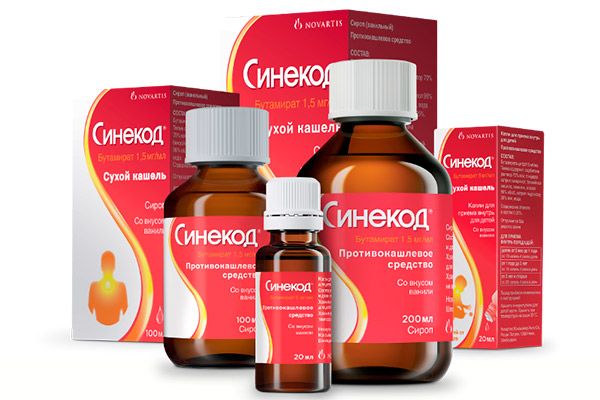
The question of what kind of cough Sinekod is used for: dry or wet, does not make sense, since antitussive drugs are used strictly for dry coughs without sputum secretion, otherwise the drug can only cause harm. Doctors can prescribe the drug:
- for whooping cough in children,
- to reduce the intensity of cough in smokers,
- to suppress the cough reflex during diagnostic studies of the bronchopulmonary system,
- in preparation for surgical operations,
- for cardiac cough without sputum formation.
In infectious and inflammatory respiratory pathologies, Sinekod can be prescribed only at the stage of dry cough, mainly in the recovery period, less often in the initial stage of the disease (if coughing fits are too painful, which negatively affects the patient's condition).
The drug is available in 3 forms:
- syrup,
- drops,
- dragee.
Pharmacodynamics. The active substance of the drug is butamirate. The main effect of the drug is to reduce the activity of the cough center, due to which the number and quality of coughing attacks is noticeably reduced, up to their complete disappearance. Additionally, the drug promotes the expansion of the bronchi (bronchodilating effect), prevents spasms of the respiratory tract, improves blood oxygen saturation, i.e. facilitates and improves the quality of breathing.
Pharmacokinetics. The active substance is absorbed in the intestine, and after an hour and a half its content in the blood reaches its maximum. It does not accumulate in the body. It is slowly excreted in the urine (the half-life reaches 6 hours).
Contraindications for use. The drug is not prescribed in case of hypersensitivity to its components. Despite the fact that the use of the drug is not prohibited during pregnancy, one should be careful when prescribing it during the first 3 months.
Some precautions should be taken when prescribing various forms of the drug, especially for children. For example, Sinekod drops can be used from 2 months of age, syrup - from 3 years, and tablets (pills) - not earlier than 6 years of age.
The Sinekod syrup for dry cough contains sorbitol, which means it cannot be prescribed to patients with hereditary fructose intolerance.
Side effects. The fact that the drug can be used even in infants indicates the relative safety of the drug. Usually, children and adults tolerate the drug well without any unpleasant symptoms. However, in rare cases, the following reactions are possible: drowsiness and dizziness (they disappear when the dose is reduced), nausea and diarrhea, skin rashes, allergic reactions.
In very rare cases, swelling of the larynx is possible, especially in children. However, the probability of such an event is much lower than with other drugs.
Method of administration and dosage. It should be said right away that not only the form of release, but also the recommended dosage depends on the patient's age.
"Sinekod" can be prescribed to a child for a dry cough in the form of:
- drops (from 2 months to a year – 10 drops per dose, from 1 year to 3 years – 15 drops),
- syrup (from 3 to 6 years old – 5 ml, from 6 to 12 years old – 10 ml, from 12 to 15 years old – 15 ml),
- tablets (from 6 to 15 years old - 1 tablet 2 times, and from 12 years old - 3 times a day).
The frequency of taking drops is 4 times, syrup – 3 times a day.
"Sinekod" for dry cough for teenagers over 15 years old and adults can be prescribed in any form of release:
- drops – from 25 to 60 drops per dose,
- syrup – 15 ml every 6 hours, i.e. 4 times a day,
- tablets – 2 dragees (frequency of administration – 2 or 3 times a day as prescribed by the doctor).
Overdose. The drug does not tend to accumulate in the blood, and its long-term use does not lead to an overdose. However, large doses of the drug taken at one time can lead to the following symptoms: lethargy, drowsiness, nausea with vomiting, diarrhea, impaired coordination, and a drop in blood pressure.
Treatment consists of gastric lavage and enterosorbents. Saline laxatives and symptomatic therapy are also indicated.
Interactions with other drugs. Sinekod may be taken simultaneously with any medications, except for dry or wet cough remedies with expectorant or mucolytic action.
Storage conditions. The instructions recommend storing the medicine at a temperature not exceeding 30 degrees in its original packaging.
Shelf life. Tablets can be stored for no more than 5 years from the date of manufacture, drops and syrup – up to 3 years.
Reviews. Most reviews of the drug are positive. The drug helps with dry barking cough. The only drawback, many consider the presence of bitterness even in syrup and drops, but this can be lived through. A small percentage of negative reviews are caused either by incorrect prescription of the drug or lack of effect due to individual characteristics of the body.
Omnitus
A centrally acting antitussive drug based on the same butamirate with minor expectorant and bronchodilator (prevention of airway obstruction, the same antispasmodic) action. The indications for use of the drug overlap with the prescriptions for the drug "Sinekod". The same can be said about the pharmacological properties and side effects of the drug "Omnitus" used for dry cough.
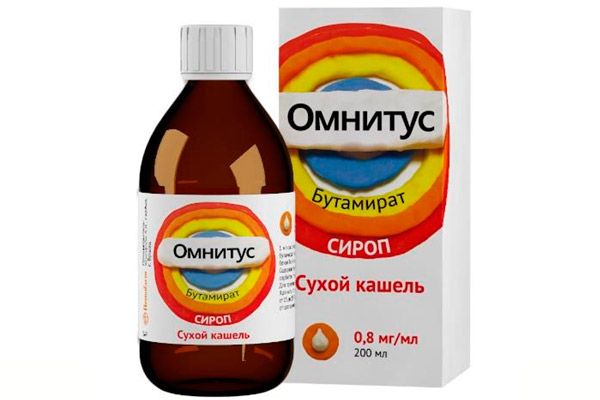
The medicine is produced in the form of syrup and tablets of different dosages.
Contraindications for use. The drug is not prescribed for hypersensitivity to its components, as well as during breastfeeding. Tablets are not recommended for use during pregnancy and for children under 6 years of age. High-dose tablets (50 ml) are prescribed only to adult patients.
"Omnitus" syrup for dry cough during pregnancy is allowed to be used only starting from the 4th month. In childhood, it is prescribed to patients from 3 years old.
Method of administration and dosage. The dosage of the drug does not depend on the pathology accompanied by a dry cough, but on the patient's age:
The syrup should be taken: for children under 6 years old – 10 ml per dose, for children from 6 to 9 years old – 15 ml. Frequency of administration – 3 times a day.
For teenagers over 9 years old, the drug is prescribed 15 ml 4 times a day, and for adults - 30 ml three times a day.
Omnitus tablets for dry cough can have a dosage of 20 or 50 mg, they must be taken whole.
The first is prescribed to children from 6 to 12 years old, 1 tablet twice a day; for teenagers 12-17 years old, the frequency of administration is increased to 3 times a day.
Adults take 2 tablets of 20 mg 2 to 3 times a day or 1 tablet of 50 mg 1 to 2 times a day.
Interaction with other drugs. During treatment with the drug, you should refrain from drinking alcoholic beverages. Caution should be exercised when taking the drug together with sleeping pills, neuroleptics, tranquilizers.
Storage conditions. The manufacturer recommends storing the drug at a temperature of 15-25 degrees, away from children and sunlight.
Shelf life. The syrup is allowed to be used for 5 years, tablets – for 2 years.
Reviews. The opinions of buyers about the drug "Omnitus" are as ambiguous as about its analogue called "Sinekod". For some, it became salvation from a dry cough, while others noted a deterioration in the condition instead of the declared transition of the cough from dry to wet. Most often, the drug is used to treat children.
Libexin
Pharmacodynamics. The active substance of the drug is prenoxdiazine, which has a calming effect not on the cough center, but on the peripheral organs (reduces the excitation of cough receptors), due to which the cough subsides. At the same time, the drug helps to expand the bronchi and reduce pain when coughing. In the treatment of chronic bronchitis, a noticeable anti-inflammatory effect was noted.
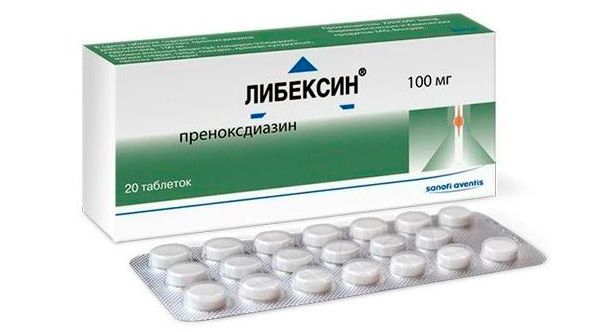
Pharmacokinetics. The drug has good absorption properties. It is absorbed already in the stomach. The maximum concentration in the blood is observed already half an hour after administration. It is excreted with feces and partly with urine. The specific effect lasts for about 4 hours.
Contraindications for use. The antitussive drug is not prescribed in case of hypersensitivity to its components and the release of abundant bronchial secretions. In pediatrics, it is used from 3 years of age due to the fact that it has a single release form in the form of tablets.
Side effects of the drug "Libexin", used for dry cough, develop very rarely. This may include dry mouth mucous membranes, dry throat, stomach pains that are relieved by eating, constipation, allergic reactions, bronchospasm. In large doses, it reduces concentration.
Method of administration and dosage. It is not recommended to crush the tablet too much to avoid a feeling of numbness of the oral mucosa. It should be swallowed whole and washed down with water.
The daily dose for adults is 3-4 tablets. Children are given 0.5 tablets 3 or 4 times a day.
An overdose of the drug is not dangerous. It manifests itself in lethargy, apathy, fatigue due to the pronounced sedative effect.
Interactions with other drugs. Libexin can be taken simultaneously with other drugs without worrying about the consequences.
Storage conditions and shelf life. It is recommended to store the tablets in their original packaging at room temperature for no more than 5 years.
Reviews: Again, the reviews are not very diverse. Some people like the drug, while others are disappointed. The main advantages of the drug are: no addiction, safe for use in children, few side effects, and the possibility of use during pregnancy. Many parents consider this drug to be the best medicine for their child.
Now let's look at how complex drugs work, which amazingly combine antitussive and expectorant effects.
Codelac
Pharmacodynamics. A complex multicomponent drug used primarily against dry cough. Contains 4 active ingredients:
- codeine (an analgesic with a narcotic effect, depresses the cough center, but not the respiratory function),
- sodium bicarbonate (changes the acidity of sputum towards a decrease in pH, therefore making it less viscous, plus has a stimulating effect on the epithelium that covers the bronchi, promoting the removal of mucus)
- licorice root extract (expectorant and antispasmodic)
- Thermopsis lanceolata herb (stimulates the respiratory center and has an expectorant effect, stimulating the activity of the bronchial glands and bronchial epithelium).
Since the drug is multicomponent, it is very difficult to judge the pharmacokinetics. It can only be noted that the effect of taking the drug is observed after ½-1 hour and lasts for 6 hours.
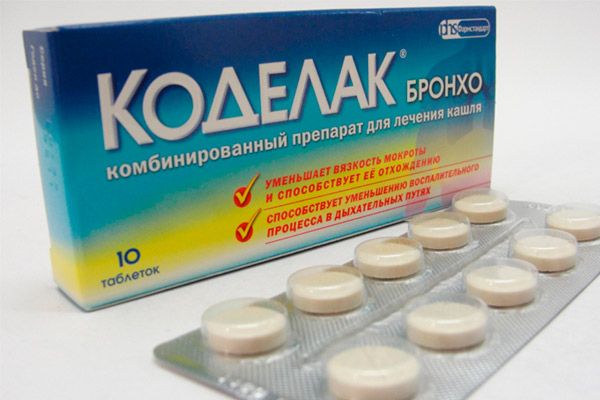
Contraindications for use. The drug should not be prescribed if there is intolerance to at least one of the components, to patients with respiratory disorders and bronchial asthma, as well as to those who suffer from chronic alcoholism. The drug can be prescribed to children from 2 years of age, and only in extreme cases.
Caution and dose adjustment are required in case of severe kidney pathologies and increased intracranial pressure.
Use during pregnancy and lactation is not possible.
The side effects of the drug are caused by the presence of a narcotic substance (drowsiness, decreased concentration and visual acuity, episodes of dizziness and headaches) and other components (nausea with vomiting, changes in stool, abdominal pain, dry mucous membranes, allergic skin rashes, angioedema).
Method of administration and dosage. It is available in the form of tablets that can be taken without worrying about the interval between meals. The tablets are swallowed whole and washed down with water.
The dosage for adults is 2-3 tablets per day (no more than 200 mg), the child's dose is determined by the doctor. Treatment with the drug is short-term. Up to 5 days.
Overdose. Taking large doses of the drug can increase side effects, decrease blood pressure, weaken the pulse, irregular heartbeat, severe fatigue, and decrease in bladder tone.
Treatment consists of gastric lavage and taking sorbents. The antidote is naloxone. Symptomatic therapy is also carried out.
Interaction with other drugs. It is prohibited to take the drug together with drugs that depress the central nervous system, including anti-allergy drugs and central analgesics.
Chloramphenicol inhibits the excretion of codeine, thereby prolonging its action. "Codelac" acts in a similar way against cardiac glycosides.
Antacids and astringents reduce the effectiveness of the drug.
"Codelac" for dry cough is not prescribed simultaneously with mucolytics and expectorants.
Storage conditions and shelf life. The medicine is stored at room temperature for 4 years.
Reviews. Patients' opinions about the drug are generally positive. It really helps with a debilitating cough, making it easier and more productive. But many are still confused by the presence of a drug in the composition of the medicine. For this reason, mothers are afraid to give it to their children. And you can't drive while being treated with such a drug.
On the shelves of pharmacies you can find 2 more variants of the above-described drug: "Codelac Neo" and "Codeac Broncho". "Codelac Neo" with the active substance butamirate is prescribed strictly for dry cough. This is an analogue of the drugs "Sinekod" and "Omnikus", which can safely treat children from 2 months and adults. Release forms: drops, syrup, tablets.
"Codelac Neo" for dry cough in children is prescribed mainly in the form of drops and syrup. "Codelac Neo" syrup for dry cough has 2 dosages: 100 and 200 ml. The first is enough to treat children under 6 years old (5 ml 3 times a day). The second is used to treat older children, teenagers and adults (from 10 to 15 ml 3-4 times a day depending on age).
"Codelac Broncho" is not prescribed for dry cough, because the instructions strictly state that it is intended for the treatment of wet cough with difficulty in expectorating sputum.
StopTussin
This is truly a synthetic drug with a complex effect. It is an antitussive, expectorant and mucolytic drug all rolled into one.
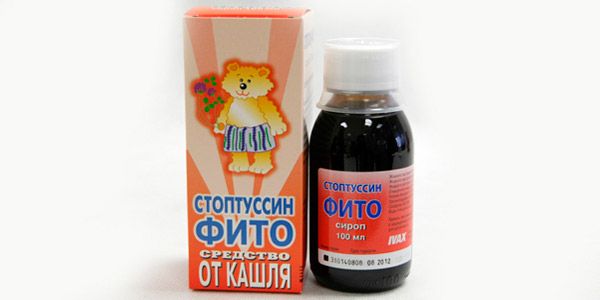
Pharmacodynamics. The drug contains 2 active ingredients:
- butamirate is an antitussive component of peripheral action with a sedative and analgesic effect,
- guaifenesin, which helps to thin and remove mucus, and stimulates its production.
The action of both components is compensated, so its use does not lead to blockage of the bronchi.
Pharmacokinetics. The active substances of the drug are quickly absorbed in the gastrointestinal tract, their metabolites (active and inactive) are excreted mainly through the kidneys, and only a small part is observed in the feces.
Release form. The medicine can be found in pharmacies in the form of tablets or drops.
Contraindications for use. The drug is not prescribed in case of hypersensitivity to its components, myasthenia, during breastfeeding. During pregnancy, the drug can be taken starting from the second trimester.
Children are prescribed tablets from the age of 12, drops - from 6 months.
Side effects. If you take the drug in recommended doses, the likelihood of developing unpleasant effects is very low. 1 patient out of 100 may complain of nausea and vomiting, diarrhea, loss of appetite, epigastric pain, drowsiness, chest pain. Headaches and dizziness are slightly more common complaints.
Method of administration and dosage. The dosage of the drug strictly depends on the patient's weight.
The tablets should be taken whole with water. Recommended doses:
- for patients weighing less than 50 kg the dose will be half a tablet 4 times a day,
- for those whose weight is between 50 and 70 kg – 1 tablet three times a day,
- if you weigh more than 70 but less than 90 kg, you need to take one and a half tablets three times a day,
- if the body weight exceeds 90 kg, the dosage remains the same (1.5 tablets), but the frequency of administration increases to 4 times a day.
Before use, the drops are diluted in half a glass of water or another non-carbonated soft drink.
Dosage for children:
- babies weighing less than 7 kg are prescribed 8 drops, the medicine should be taken 3 to 4 times a day,
- children whose weight is between 7 and 12 kg should take 9 drops per dose with the same frequency of administration,
- if the child's weight is more than 12 but less than 20 kg, he is prescribed 14 drops, taken 3 times a day,
- schoolchildren weighing from 21 to 30 kg are given the same number of drops, but the frequency of administration can be increased to 4 times a day,
- for weights over 30 but less than 40 kg, the drug is prescribed in the amount of 16 drops with a frequency of administration of 3-4 times a day,
Dosage for adults:
- patient weight 40-50 kg – dose 25 drops,
- patient weight 50-70 kg – dose 30 drops,
- for a body weight of 71 kg and above, the effective dosage will be 40 drops.
Frequency of administration: three times a day.
The drug may come with a special syringe for easy dosing of the medicine. It allows you to measure the medicine without opening the bottle.
Overdose. Guaifenesin is a fairly toxic component, so exceeding the recommended dose can cause symptoms of intoxication in the form of muscle weakness, drowsiness, nausea, and vomiting.
Help: cleansing the stomach, taking sorbents, symptomatic therapy.
Interaction with other drugs. Drugs containing trace elements lithium and magnesium may enhance the expectorant effect of the drug.
Guaifenesin enhances the effect of acetylsalicylic acid and paracetamol. An identical effect is observed with recent alcohol consumption, as well as with the simultaneous use of the drug and muscle relaxants, sleeping pills, drugs with a narcotic effect.
Storage conditions and shelf life. It is recommended to store the medicine at room temperature in a dark place for no more than 5 years.
Reviews: Most reviews of the drug indicate its high effectiveness as a remedy for dry cough. However, there are also negative reviews, some of which are related to the lack of the expected effect (after all, the drug is not cheap), and others are characterized by an emphasis on the unpleasant bitter taste of the drug, which makes it difficult to treat children with it, and the smell of alcohol.
We have reviewed the most popular remedies prescribed for dry cough, which reduce its severity and pain. It is time to get acquainted with the drugs that have an expectorant effect and are used for dry cough much more often than antitussives.
Expectorants for dry cough
Such drugs are not designed to stop the cough, but to alleviate it by increasing the amount of mucus secreted by the bronchi and stimulating the bronchi to remove it.
Mucaltin
Well, who doesn’t know this natural expectorant drug, which has been known since Soviet times and has not lost its relevance to this day.
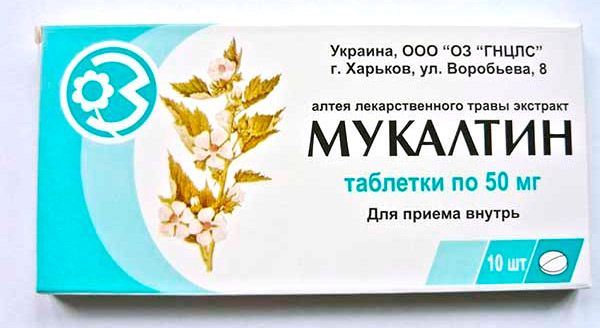
Pharmacodynamics. The active substance of the drug - mucaltin - is a polysaccharide of the marshmallow plant. It is impossible to answer the question of what kind of cough "Mucaltin" is for: dry or wet, because doctors prescribe the drug with equal success for both dry cough and difficult wet cough. The drug helps to expand the bronchi (bronchodilator) and liquefy sputum (secretolytic). Partially weakens the cough, making it softer and rarer, facilitates the supply of sputum from the lower respiratory tract upward, stimulating the peristalsis of the bronchioles and the activity of the epithelial receptors of the bronchi.
The pharmacokinetics of the drug have not been sufficiently studied, but it is known that it belongs to the category of low-toxic drugs.
Contraindications for use. Hypersensitivity to the components of the drug. In pediatrics, it is used from 1 year.
Use during pregnancy. The instructions for the drug do not say anything about the possibility of using the drug during this period. But since the active substance of the drug is the polysaccharide marshmallow, and the plant itself is prohibited for use before the 4th month of pregnancy, then most likely an expectorant drug with secretolytic activity should not be used in the 1st trimester of pregnancy.
Side effects of the drug are limited to mild allergic reactions.
Method of administration and dosage. Mucaltin is available in the form of brownish tablets that must be swallowed whole.
Patients over 12 years of age are prescribed 2 tablets per dose. The medicine should be taken in this dosage 4 times a day before meals.
"Mukaltin" for dry cough for a child under 3 years old is prescribed 1 tablet three times a day, for older children the dose is left the same, and the frequency of administration is increased to 4.
For small children, the tablets are dissolved in a third of a glass of water, sweetened with sugar or fruit syrup.
The course of treatment can be long: from 1 week to 2 months.
Overdose may occur with prolonged use of high doses and will manifest itself in the form of nausea and vomiting.
Interaction with other drugs. No dangerous reactions were observed when using Mucaltin and other drugs simultaneously. Do not prescribe together with antitussives.
Storage conditions and shelf life. Mucaltin should be stored at temperatures not exceeding 25 degrees for no more than 4 years.
Reviews: According to many patients, Mukaltin has been unfairly replaced by less effective innovative drugs. But in fact, it is an effective and inexpensive remedy for dry and difficult wet cough, which helps to safely solve the problem even for people with financial difficulties.
Pertussin
A popular expectorant combination drug based on thyme extract and potassium bromide. Like Mucaltin, it is considered an effective budget drug. Pertussin is most often prescribed for dry cough.
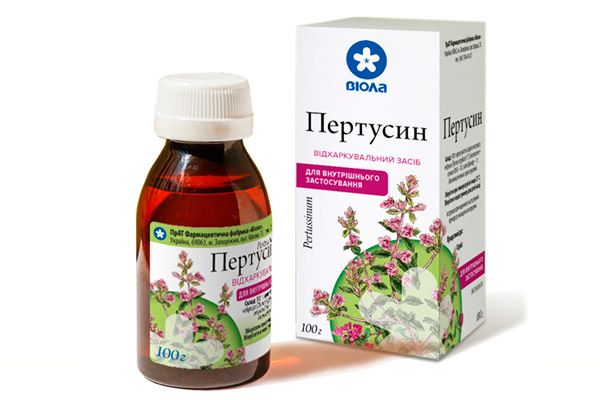
Pharmacodynamics. Potassium bromide (synthetic component) in the drug provides a sedative effect on the central nervous system, due to which the cough reflex is somewhat reduced.
Liquid extract of thyme (plant part) with its inherent bitterness simulates the serketory and motor function of the bronchi and bronchioles, helps to reduce the viscosity of sputum and its active removal.
The drug is available in one form - sweet syrup in 100 g dark bottles. Contains alcohol.
The effective and popular cough remedy has quite a few contraindications for use. These include intolerance to the components of the drug, intractable heart failure, hypotension, vascular atherosclerosis, anemia, kidney disease, diabetes. As well as impaired glucose absorption and chronic alcoholism, which is associated with the inclusion of sugar syrup and ethyl alcohol in the drug.
In pediatrics, it is used from 3 years of age. It is not recommended to take during pregnancy and lactation.
Side effects are usually observed with long-term use of the remedy for dry cough. This may include nausea, heartburn, allergic reactions. Excess bromides can also cause the following symptoms: depressed state, depression, appetite and sleep disorders, decreased libido, movement coordination disorder, rhinitis, conjunctivitis, skin rashes.
Method of administration and dosage. For patients over 12 years of age, the syrup is prescribed in a dosage of 15 ml three times a day.
The dosage for children depends on age. For children under 6 years of age, a single dose (2.5 ml) is diluted with water (20 ml). Children aged 6-9 years are prescribed 5 ml, 9-12 years - 10 ml of syrup per dose. The frequency of administration in all cases is 3 times a day.
Overdose. Taking large doses of the drug over a long period of time leads to the appearance of symptoms of bromism. In this case, the drug is discontinued, saline laxatives and plenty of fluids are given, and symptomatic therapy is carried out.
Interaction with other drugs. No dangerous interactions have been observed. It is not recommended to use simultaneously with antitussives.
Storage conditions and shelf life. It is recommended to keep the drug away from children and store at a temperature not exceeding 25 degrees. Effective for 4 years.
Reviews of the drug are overwhelmingly positive, both from doctors and patients.
In pharmacies, you can occasionally find the German drug "Pertussin" in tablet form, but its effectiveness is lower due to the absence of potassium bromide in the composition.
Doctor MOM
Pharmacodynamics. An effective herbal preparation based on 10 herbs with a pronounced expectorant effect. Helps clear the bronchi, stimulating the liquefaction and removal of phlegm, and has a good anti-inflammatory effect. The drug "Doctor MOM" for dry cough is prescribed in the form of syrup or lozenges with fruit and berry flavors, which children really like, but they are prescribed only to adult patients.
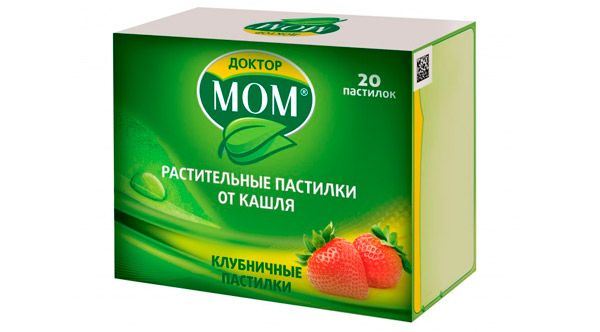
Contraindications for use. The syrup is not prescribed for hypersensitivity to the components of the drug and under 3 years of age. The lozenges are intended for the treatment of adult patients, but are not recommended during pregnancy and lactation.
The syrup and lozenges contain sugar, which should be taken into account by patients with high blood glucose levels.
Side effects. Allergy to any of the components of the drug is possible.
Method of administration and dosage. Adult patients are prescribed the medicine in any form of release. The lozenges should be sucked at intervals of 2 hours, no more than 10 pieces per day.
The syrup is prescribed 5-10 ml three times a day.
Children aged 3-6 years are prescribed syrup in a dosage of 2.5 ml, children under 14 years - 2.5-5 ml with a frequency of administration three times a day. Teenagers over 14 years take adult doses.
The therapeutic course can last from 14 to 21 days.
There is no information about overdose and dangerous drug interactions. However, the drug is not recommended for use with antitussives.
Storage conditions and shelf life. The drug remains effective for 2 years if stored at temperatures no higher than 30 degrees.
Reviews: The drug has mostly positive reviews. But many patients note the short-term effect of taking lozenges and syrup, as well as insufficient effectiveness in case of severe cough. As part of complex therapy, the drug has a very good and fast effect.
 [ 7 ]
[ 7 ]
Prospan
An effective expectorant based on dry ivy extract. What kind of cough is Prospan for: dry or wet? The beneficial properties of the drug bring relief for both dry and wet coughs.
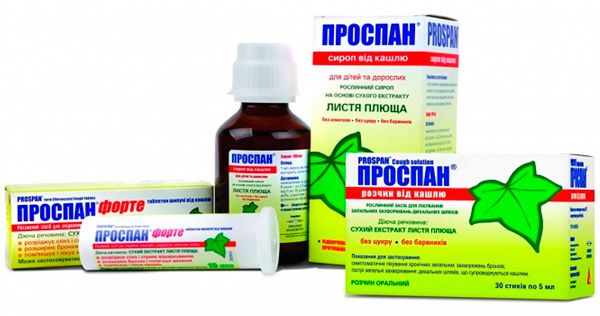
Release form. It should be noted right away that everyone can find a form of the drug that meets their needs. After all, the medicine can be found in pharmacies in the form of syrup (dosages of 100 and 200 ml), effervescent tablets, oral solution for cough, drops, lozenges,
Pharmacodynamics. Saponins contained in ivy provide the following effects to the drug: increase in the amount of sputum and decrease in its viscosity, stimulation of the respiratory tract to remove the formed mucus, expansion of the bronchi due to the removal of spasms, mild antitussive and antimicrobial effect. Does not affect the respiratory centers.
The pharmacokinetics of the drug have not been described.
Contraindications for use. Hypersensitivity to the components of the drug and fructose intolerance.
Not recommended for use during pregnancy due to lack of proven data.
Side effects. Complaints are extremely rare. In CT diseases, nausea, vomiting, diarrhea, and epigastric pain may be observed. Allergic reactions occur only in isolated cases.
Method of administration and dosage. Take 2-3 effervescent tablets per day, dissolving them in a glass of water (preferably hot). I prescribe them to patients over 4 years old. Children under 12 are prescribed half a tablet three times a day. Older patients - 1 tablet twice a day.
Dry and wet cough syrup "Prospan" is approved for use in pediatrics from the very birth of the child. Infants and toddlers up to 6 years of age are prescribed 2.5 ml of syrup per dose. Patients aged 6-18 years are recommended a dose of 5 ml, over 18 years 0 from 5 to 7.5 ml. The frequency of taking the medicine is 3 times a day.
The cough solution "Prospan" is sealed in sticks, which must be crushed before use. Take the solution without diluting it with water. Recommended for use from the age of 6.
Children from 6 to 12 years old are prescribed 1 stick twice a day. Older patients are given the solution in the same dosage, but 3 times a day.
Prospan lozenges are also intended for patients over 6 years of age. Up to 12 years of age, 2 lozenges are prescribed per day, after – 4 lozenges.
Prospan drops are approved for use from the age of one year. Children under 4 years old are given 12 drops, from 4 to 10 years old - 16 drops, over 10 years old - 24 drops per dose. The frequency of taking the medicine is 3 times a day.
The course of treatment usually takes at least 1 week.
Overdose. Taking high doses may cause the following symptoms: nausea with vomiting, diarrhea, increased excitability, anxiety. Dose reduction and symptomatic treatment are required.
Interaction with other drugs. The medicine can be used with any other drugs.
Storage conditions and shelf life. Any form of the drug should be stored at room temperature in a dark place for no more than 3 years. After opening the bottle with syrup, it should be used within 3 months.
Reviews: Like other dry cough remedies, Prospan has opposite reviews. Parents consider its pleasant taste and the possibility of using it from birth to be its advantage, and its disadvantage is the high price of the drug, which shows good results mainly in complex treatment.
Licorice Root Syrup
People have known for a long time that the medicinal plant licorice with its sweetish taste is useful for coughs. And soon pharmacists became interested in it. Thus, another inexpensive but very effective drug appeared.
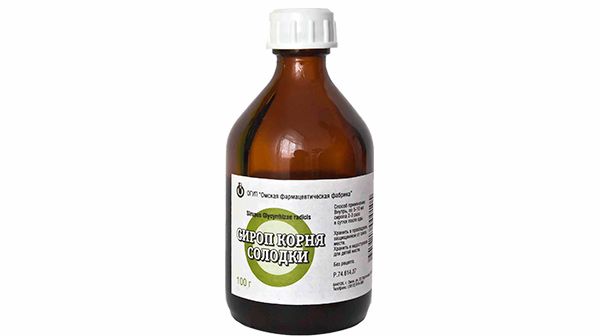
What kind of cough does licorice help with: dry or wet? Most often, the plant is used to facilitate expectoration if the patient suffers from a dry cough. But it will also be useful if the cough is productive, but the mucus formed in the respiratory tract does not want to leave the body on its own.
Pharmacodynamics. The syrup was created not on the basis of the plant itself, but on its root. Licorice root contains many useful substances, among which glycyrrhizin stands out - a substance that stimulates the activity of the respiratory epithelium and increases the amount of secretion produced. And this is very important for dry cough. Other substances contained in licorice help relieve inflammation and prevent spasms of the bronchial muscles, which also alleviates coughing and the condition of the respiratory tract.
There are no data on the pharmacokinetics of the drug.
Contraindications for use. The syrup cannot be used in case of hypersensitivity to its components, severe liver and kidney pathologies in which their function is impaired, potassium deficiency (hypokalemia), arterial hypertension, obesity of 2-3 degrees. In pediatrics, it is used from 1 year.
The syrup contains sugar, which should be taken into account by patients with diabetes.
Use during pregnancy is prohibited due to the risk of increased estrogen levels, which can cause premature birth. Breastfeeding is also stopped during treatment with licorice.
Side effects: Rarely, in case of hypersensitivity, allergic reactions may occur, including swelling of the throat.
If licorice for dry cough is taken in high doses for a long time, it can lead to a disruption of the water-electrolyte balance, and as a consequence, hypokalemia, which manifests itself as edema syndrome, increased blood pressure, muscle pain and muscle atony.
Method of application and dosage. Doctors advise taking licorice syrup for dry cough immediately after meals.
If the patient is over 12 years old, he needs to take 15 ml of syrup at a time.
Licorice for dry cough for children is prescribed based on the child’s age:
- the dose from one year to three years will be 2.5 ml,
- children from 4 to 7 years old may be prescribed from 2.5 to 5 ml,
- The dose for schoolchildren under 9 years of age ranges from 5 to 7.5 ml, and for older teenagers it can reach 10 ml.
Regardless of the patient’s age, the drug is taken 3, in some cases 4 times a day, as prescribed by the doctor.
Overdose. Most often, it manifests itself in the form of increased side effects, and in particular, hypokalemia may develop.
Interaction with other drugs. Cardiac glycosides and drugs used for arrhythmia, thiazide and loop diuretics, and anticonstipation drugs increase the likelihood of hypokalemia and enhance its symptoms.
Storage conditions and shelf life. At temperatures within 20-25 degrees, the syrup is perfectly stored for 2 years. If the bottle has been opened, the medicine should be used within a maximum of 6 months.
Reviews: Many buyers are simply surprised that a cheap syrup gives such a good effect, which they did not wait for from more expensive drugs. The taste of the drug is also pleasing. Of the disadvantages, everyone points out only the presence of alcohol.
Althaea syrup
Another medicinal plant, used for a long time for dry cough, is called marshmallow. A medicinal syrup is made from its root.
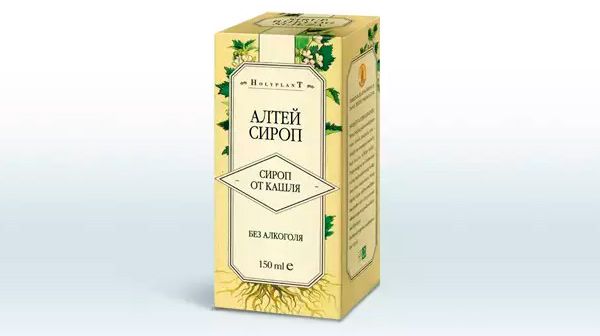
Pharmacodynamics. Marshmallow root, like licorice, contains many useful substances: polysaccharides, pectins, starch, amino acids. It is due to them that the medicine has many properties that relieve cough: it coats the mucous membrane of the respiratory tract, softens it and relieves inflammation, increases the amount of mucus secreted and makes it more liquid, stimulates the peristalsis of the bronchioles and the activity of the bronchial epithelium, thereby providing an expectorant effect.
Pharmacokinetics have also not been studied.
Contraindications for use. The drug should not be taken if you are intolerant to any component of the drug. It is prohibited to take it during pregnancy and breastfeeding. Caution should also be exercised in case of diabetes. Children are prescribed the sweet medicine from the age of 2.
Side effects. The drug is well tolerated, only rarely causing allergic reactions.
Method of administration and dosage. Unlike licorice syrup, marshmallow extract should be taken before meals, shaking the bottle.
Adolescents over 14 years of age and adult patients are prescribed the medicine in a single dose of 15 ml, which corresponds to an incomplete tablespoon.
The dose for children under 6 years of age is 5 ml, and for older children - 10 ml. For children under 6 years of age, it is advisable to dilute the drug containing alcohol with water in a ratio of 1:2 or 1:3.
The frequency of taking the drug can vary from 4 to 6 times a day. The course of treatment is usually 1-2 weeks.
There have been no reports of drug overdose.
Interaction with other drugs. The drug should not be taken together with antitussive drugs.
Storage conditions and shelf life. The drug can be stored at a temperature not exceeding 25 degrees for 2 years. If the bottle has been opened, it will have to be stored in the cold (5-8 degrees) and for no more than 14 days.
Reviews: Opinions about this drug coincide with reviews about licorice syrup. Cheap and quite effective.
Tablets and mixtures with thermopsis
We have already mentioned thermopsis and its expectorant properties when considering the drug "Codelac". So it is not surprising that thermopsis in the form of tablets, decoctions and mixtures is used for dry cough.
Release form. On the shelves of pharmacies you can find mainly tablets with Thermopsis under different names: "Termopsol", "Antitusin", "Cough tablets". Dry extract of the herb, its infusion and mixture are used less often.
Contraindications for use. Regardless of the form in which the drug is released, it cannot be prescribed in the following cases:
- hypersensitivity to the components of the drug,
- gastric and duodenal ulcers during exacerbation,
- lung pathologies that pose a risk of hemoptysis,
- acute stages of inflammatory kidney diseases (pyelonephritis, glomerulonephritis),
- age under 12 years (in practice it is prescribed from 6 years),
- periods of pregnancy (increases uterine tone) and breastfeeding (contains alkaloids).
Sometimes Thermopsis can be prescribed to pregnant women, but as an exception and only in the last month of pregnancy.
Side effects. Taking Thermopsis preparations may be accompanied by symptoms such as nausea and vomiting, epigastric pain, and the development of allergic reactions of varying severity.
Method of administration and dosage. Tablets are taken regardless of food intake, swallowed whole and washed down with water.
The dosage for adults and adolescents over 12 years of age is 1 tablet per dose. The children's dose is 2 times less (half a tablet).
The medicine should be taken 3 times a day.
Children from 4 months can be given thermopsis infusion (0.2 grams of crushed herb per glass of water, heated for a quarter of an hour in a water bath). The dosage for babies under one year is 5 ml of infusion, 2-3 times a day. Children over 1 year old are given 10 ml of infusion per dose 3 to 4 times a day.
To prepare the infusion for patients over 6 years old, take 3 times more herbs for the same amount of water. Children under 12 years old should take 5 ml of the infusion 4 to 3 times a day. For older patients, the single dose is increased to 15 ml with the same frequency of administration.
Dry extract of thermopsis is intended for the treatment of patients over 6 years old. Single dose for children under 12 years old is 0.025 g, for adults - 0.05 g. The doctor may prescribe taking the extract 2 or 3 times a day, diluting it in water (1-3 tablespoons).
Cough mixture in bags is recommended for patients over 12 years old, although its use at the age of 6-12 years is not excluded. Before use, the mixture is diluted with water.
Adult dosage: 1 sachet 3-4 times a day, children's dosage: 2 times less with the same frequency of administration.
The course of treatment is short (from 3 to 5 days).
Overdose. If you take high doses of the drug, nausea and vomiting may occur. In this case, gastric lavage, sorbents and antiemetics are necessary.
Interaction with other drugs. Any form of the drug is prohibited to be taken together with antitussives.
Enterosorbents, antacids, agents with enveloping and astringent properties inhibit the absorption of the active substances of the drug, so the interval between their administration should be at least 1-1.5 hours.
Storage conditions and shelf life. Thermopsis infusion should be stored in the refrigerator for no more than 3 days. Other forms of the drug retain their properties when stored at room temperature, in a place protected from light. Tablets are stored for up to 4 years.
Reviews: Thermopsis-based medicines have very good reviews. Only 5 people out of 100 can say that, unfortunately, there was no improvement.
Mucolytics and complex drugs
Perhaps, mucolytics are not used as often as expectorants for dry coughs, however, they are actively prescribed if the cough is not completely dry, the urge to cough is quite strong, and the sputum does not come off due to its high viscosity. Drinking plenty of fluids also helps in this case, but if it does not give results, you have to resort to medications, especially since many mucolytics also have some expectorant effect.
Ambroxol
Mechanism of action: The drug effectively liquefies phlegm and stimulates the formation of a special substance in the lungs that regulates the production of secretions and their characteristics.
What kind of cough is ambroxol for: dry or wet? The drug can be used equally successfully for different types of cough, if the expectoration of sputum is difficult.
All oral forms of the drug are quickly absorbed in the gastrointestinal tract, distributing throughout the body. Its highest concentration is observed in the lungs. The maximum concentration can be observed after half an hour, although for tablets it may occur later. It penetrates into various liquid environments, including breast milk. It does not accumulate in the body. It remains effective for more than 7 hours. The kidneys are responsible for excreting the drug.
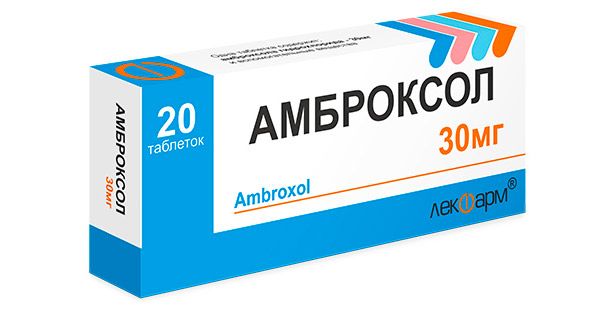
The drug can be found in pharmacies in the form of syrup of various concentrations, tablets and inhalation solution in ampoules.
What are the contraindications? As usual, the main obstacle to using the medicine is intolerance to its components. But doctors also do not recommend taking it for gastric ulcer and duodenal ulcer, convulsive syndrome.
Use during pregnancy is limited, because in the early stages and during breastfeeding the drug can have a negative effect on the baby.
Side effects occur in rare cases and manifest themselves as nausea, heartburn, heaviness and a feeling of fullness in the stomach, migraine, and taste disturbances. Other symptoms are observed very rarely.
How to take the medicine correctly? Tablets are prescribed to adult patients in most cases. It is recommended to take the medicine after meals, without chewing, with clean water. You will have to take 2-3 tablets per day.
Syrup 30 mg/5 ml is a drug for patients over 12 years of age. It is prescribed in a dosage of 10 ml per dose with a frequency of three times a day. After three days, the frequency is reduced to 2 times a day.
Syrup 15 mg/5 ml is considered a children's medicine. It can be given from the neonatal period in the following dosages:
- Children under 2 years of age receive 2.5 ml per dose twice a day,
- from 2 to 6 years of age, the medicine is given in the same dosage, but 3 times a day,
- Children under 12 years of age should take 5 ml of syrup, depending on the doctor’s instructions, 2 or 3 times a day.
The solution in ampoules is already heavy artillery. It is used mainly in difficult and advanced cases for intramuscular and intravenous injections. Adult patients are administered the drug 2 or 3 times a day in the amount of 2-3 ampoules. Children of different ages are prescribed from half to 1 ampoule, which are administered with the same frequency.
The therapeutic course usually does not exceed 5 days.
Syrup 15 mg/5 ml can also be taken by patients with diabetes.
There were no reports of drug overdose.
Possibilities of use with other drugs. It is not advisable to combine the drug with antitussives. The drug can increase the concentration of antibiotics in the blood.
Ambroxol syrup should be stored in a dry place protected from the sun at room temperature for no more than 2 years. An opened bottle should be stored for no more than a month. The shelf life of the tablets is 3 years.
Reviews: According to many users, this is the best cough medicine. The effectiveness is pleasing, as is the price of the tablets and syrup. The syrup has a pleasant taste.
Lazolvan
A very popular drug that does not need advertising. Doctors prescribe it to both children and parents, which is very convenient. The active substance of the drug is the same ambroxol, so the question of what kind of cough Lazolvan is for: dry or wet, is no longer relevant, because we discussed it when considering the previous drug.
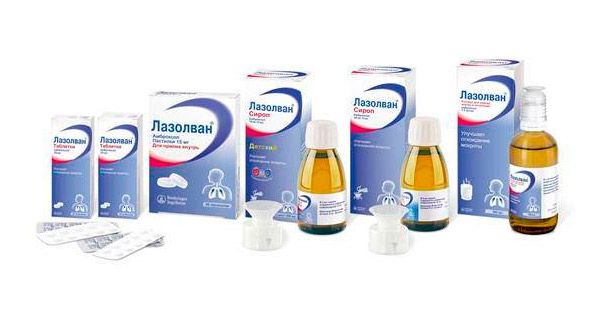
By the way, "Lazolvan" is produced in the same forms as "Ambroxol". However, the medicine can also be found in the form of a solution for oral administration in vials.
"Lazolvan" for dry cough for children can be purchased in 3 forms: as a syrup and a solution used for inhalation or injection, as well as a composition for oral administration. Tablets in a dosage of 15 mg are allowed to be given to children from 6 years of age. From 12 years old, children switch to an adult dosage, which corresponds to the doses of the drug "Ambroxol".
The oral solution is recommended in the following dosages:
- patients 12 years and older take 4 ml of solution first 3 times a day, and after a couple of days 2 times a day,
- children over 5 years of age are prescribed to take 2 ml of the drug 2 or 3 times a day,
- Children under 5 years of age are given a dose of 1 ml, the frequency of administration is determined by the doctor.
How to store the medicine? Any form of the drug is best stored at temperatures no higher than 25 degrees, away from sunlight and for no more than 5 years.
Reviews: Users like the quick positive effect of taking the drug. Very effective as an inhalation product. The syrup has a very convenient measuring cup. The disadvantage is a fairly high price compared to the analogue "Ambroxol".
Bromhexine
Another popular budget cough medicine that can be purchased in the following forms: tablets with different dosages, syrup in bottles of 60 to 120 ml, solutions (oral and inhalation).
Pharmacodynamics. Low-toxicity drug that increases sputum production and reduces its viscosity. Somewhat increases the activity of the ciliated epithelium of the respiratory tract. The active substance of the drug - bromhexine - is similar in action to ambroxol.
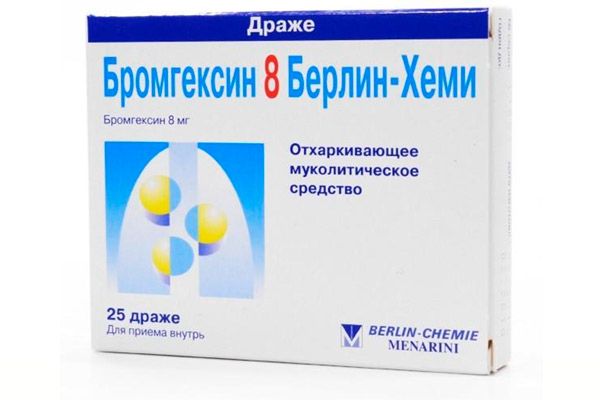
What kind of cough is Bromhexine for: dry or wet? For any cough that requires relief from bronchial secretions.
Pharmacokinetics. The drug in any form is quickly absorbed into the blood, where it reaches its maximum concentration an hour after administration. Its half-life is almost 2 times longer than that of ambroxol. It is excreted mainly by the kidneys. Good penetrating ability allows bromhexine to enter various physiological fluids. Breast milk and amniotic fluid are no exception.
In what cases is Bromhexine contraindicated? It is strictly not recommended to use the drug in case of hypersensitivity, exacerbation of gastric ulcer and duodenal ulcer. The syrup is not prescribed for fructose intolerance. The use of bromhexine in early pregnancy and during breastfeeding is highly undesirable.
Side effects are rare and may include nausea with episodes of vomiting, dyspepsia, dizziness, fever, liver dysfunction or allergic reactions.
How to take the medicine correctly? "Bromhexine" tablets for dry cough are approved for use from the age of 2. They can be swallowed whole or broken into smaller pieces (for children, they can be crushed into powder and diluted with water).
Children under 6 years of age are given half a tablet 3 times a day. Patients over 6 years of age take one tablet 3 or 4 times a day. The dose can be increased.
The syrup is supplied with a measuring spoon to make it easier to measure out the required dose. Infants and children under 6 years old are given 1 measuring spoon three times a day. For children under 14 years old, the dosage is increased to 2 spoons, and the frequency of administration is not changed.
Patients over 14 years of age may be prescribed 2 to 4 spoons three times a day.
After completing the course of treatment (4-5 days), it is necessary to clarify the possibility of further taking the medication.
There have been no reports of serious overdose, but it is not worth testing.
The drug can be combined with any medications except antitussives. But it should be remembered that bromhexidine can increase the concentration of antibiotics in the blood.
The medicine of any form of release should be stored at a temperature not exceeding 25 degrees. The syrup (if the bottle has not been opened) retains its effectiveness for 3 years, an open bottle can be stored for no more than a month. The tablets have a shelf life of 3 years.
Reviews: Before the appearance of the drug "Lazolvan", the tablets "Bromhexine" enjoyed wide and deserved popularity. But more expensive drugs tend to displace budget ones. Alas, users note that the former Soviet drug was much more effective than the modern imported one.
ACC
Many people know this drug for the tasty drinks that are made from it. Manufacturers produce the medicine in the form of effervescent tablets that dissolve in water, and powder in bags or bottles (for children), from which a hot or cold medicinal drink is made.
It is generally accepted that ACC is a medicine for colds. In fact, it is a good mucolytic, which helps to thin mucus and make it easier to remove from the body.
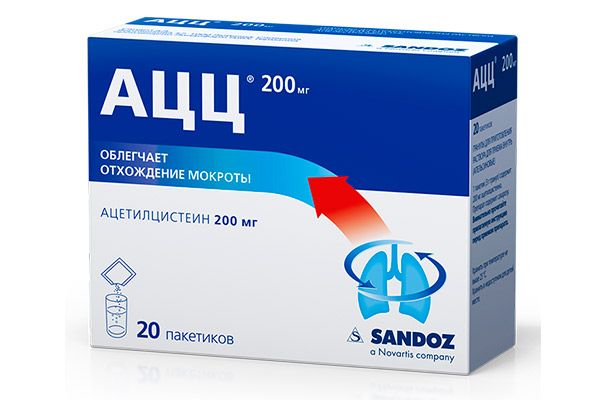
As with other mucolytics, there is no point in asking what kind of cough ACC is for: dry or wet, because these drugs are used for both dry and wet coughs, if the sputum is highly viscous and is difficult to cough up.
By the way, acetylcysteine (the active substance of the drug) has also found its application as an antidote, so the drug can be used in case of an overdose of paracetamol, aldehydes or phenols.
Pharmacokinetics. The active substance of the drug is quickly absorbed, and penetrating into the blood from the gastrointestinal tract, creates a maximum concentration there after 1-2.5 hours. Most of the metabolites are found in the urine and a little in the feces.
ACC is not prescribed in case of hypersensitivity to the drug, peptic ulcer and other ulcerative lesions of the gastrointestinal tract, pulmonary hemorrhage and hemoptysis, fructose intolerance.
In childhood, ACC is not prescribed for hepatitis and kidney dysfunction. In other cases, the drug can be prescribed as early as the 10th day of the baby's life.
Use during pregnancy is permitted with the permission of a doctor. Although the drug can accumulate in amniotic fluid, it does not have a toxic effect on the fetus.
Taking the drug may be accompanied by the development of stomatitis, dyspeptic symptoms, headache. Sometimes there are complaints of tinnitus, allergic reactions, tachycardia and decreased blood pressure.
How to take the medicine? It is recommended to take ACC for dry cough after meals to reduce the negative impact on the gastrointestinal mucosa. Tablets and powder are diluted with any liquid.
Children under 2 years of age are given only 50 mg of the drug in tablets or powder. The frequency of administration is 2 or 3 times a day. Children under 5 years of age are given 100-150 mg at a time 2 times a day. Children under 14 years of age should take 150-200 mg of the drug twice a day. The daily dose for patients over 14 years of age will be from 400 to 600 mg.
Usually, treatment with the drug is carried out for no more than 1 week, but if necessary, a course of treatment for six months is possible.
Overdose is not life-threatening and manifests itself as increased dyspepsia.
Dangerous drug interactions. In the treatment of children, ACC is not combined with tetracycline antibiotics.
The drug is incompatible with semi-synthetic antimicrobial agents from the penicillin series, as well as with cephalosporins and aminoglycosides. Caution should also be exercised when prescribing other antibiotics and nitroglycerin (the vasodilatory effect is enhanced). The interval between drug administrations should be at least 2 hours.
It is unacceptable to prescribe ACC together with antitussives.
The medicine should be stored at a temperature of up to 30 degrees. The prepared solution should be used within 12 days, provided it is stored in the refrigerator.
Reviews: Users like both the effective help for dry and difficult coughs and the taste of the drug, but are concerned about the side effects.
 [ 16 ]
[ 16 ]
Fluditec
Cough medicine in the form of syrups for children (2%) and adults (5%).
"Fluditec" is a lesser-known drug based on carbocysteine, which improves the qualitative and quantitative parameters of sputum, thereby accelerating its removal from the body. It also has an expectorant effect due to stimulation of the ciliated epithelium of the bronchi. In addition, the drug helps to strengthen the general and local immunity, has an anti-inflammatory effect on all organs of smell and hearing.
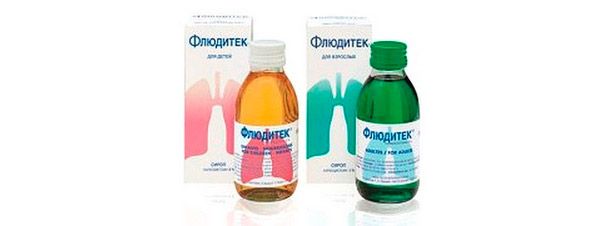
Pharmacokinetics. Rapidly absorbed in the gastrointestinal tract. Reaches the highest concentration in the blood after 2-3 hours and acts for 8 hours. Excreted by the kidneys.
The drug is dangerous to use in case of hypersensitivity to the components, exacerbation of inflammatory processes in the kidneys and urinary tract, in the acute phase of gastric ulcer and duodenal ulcer, during lactation. Caution is observed in chronic ulcerative pathologies of the gastrointestinal tract and diabetes mellitus.
During pregnancy, the drug can be taken from the 14th week and only under the supervision of a physician.
Children's syrup is intended for the treatment of children over 2 years old. The adult drug is prescribed from the age of 15.
Are there any side effects? Unpleasant symptoms during drug therapy are rarely observed. Most often, these are weakness and headaches, dizziness and stomach pain, loose stools and nausea. Allergic reactions of varying severity occur in isolated cases.
How to take the medicine correctly? The syrup should be taken between meals.
5% Fluditec syrup for dry cough is prescribed to adults at 15 ml three times a day.
2% children's syrup is given to children in a dosage of 5 ml. Up to 5 years, the medicine is given 2 times, after 5 years - 3 times a day.
The course of treatment is on average 7-10 days.
Overdose. Increased side effects are observed. Help consists of gastric lavage and administration of enterosorbents.
A synergistic effect is observed when steroids and the drug Fluditec are taken simultaneously.
The drug enhances the specific action of antibiotics and the bronchodilatory effect of theophylline.
Antitussives and atropine preparations may reduce the effectiveness of Fluditec.
How to store the medicine? Syrups are stored at room temperature for 2 years.
Reviews: Most reviews of the drug are positive, but there are also those where people claim that the drug not only did not help, but also worsened the condition. The taste seems too sweet to many, not everyone likes it. The price of the drug is also not pleasing.
Other drugs with specific action
In cough therapy, natural preparations are often prescribed that combine a pronounced expectorant and mucolytic effect. Such remedies for dry and wet cough are popular in the treatment of such categories of people as children, pregnant women, and the elderly.
Linkas
A multi-component herbal preparation with a complex effect, which is produced in the form of 3 types of syrup (regular, sugar-free and plus an effluent) and lozenges with different flavors.
Pharmacodynamics. The drug has mucolytic, antipyretic and local anesthetic effects. The active substances of the drug also stimulate the bronchial epithelium to remove phlegm, relieve inflammation and spasms.
Pharmacokinetic data are not available.
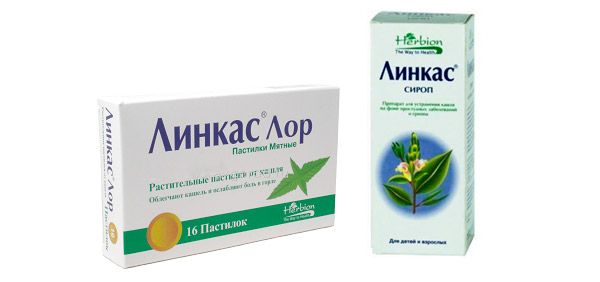
Contraindications for use. It is dangerous to prescribe syrups and lozenges to patients with hypersensitivity to their components. Sweet syrups are not allowed to be taken by patients with diabetes.
In pediatrics, sweet medicine (syrup) is used from six months. Lozenges are prescribed only to adult patients.
"Linkas" is permitted during pregnancy only with the consent of the attending physician. It is better to refrain from breastfeeding during treatment with the drug.
Side effects are extremely rare. Usually these are various allergic reactions.
Method of administration and dosage. "Linkas" for dry cough in the form of syrup is prescribed in accordance with the patient's age:
- children under 3 years of age are given 2.5 ml of syrup three times a day at a time,
- for older children the dose is increased to 5 ml, from 8 years of age the drug is taken not 3, but 4 times a day,
- Adult dose: 30-40 ml per day.
Taking the drug does not depend on the time of food consumption. It is not recommended to dilute the medicine.
Adults are prescribed one lozenge at a time, every 2-3 hours, but no more than 8 per day.
The therapeutic course usually lasts from 3 to 7 days.
Overdose. No reports.
Interaction with other drugs. It is not recommended to combine with antitussives used for dry cough.
Storage conditions and shelf life. The medicine is stored at temperatures between 15 and 25 degrees for no more than 3 years.
Reviews: Users like the price, composition, and effect of taking the medicine. However, it does not help everyone. There are reviews about side effects and the presence of dangerous additives with the letter "E".
Stodal
"Stodal" is a unique 10-component homeopathic preparation in the form of a syrup, which can be used for both wet and dry coughs.
Pharmacodynamics. The basis of the drug is plant substances that help the cough to become wet. The drug has a pronounced expectorant, bronchodilator, antispasmodic and mucolytic effect. There is also a certain antitussive effect.
It is not possible to describe the pharmacodynamics of the drug.
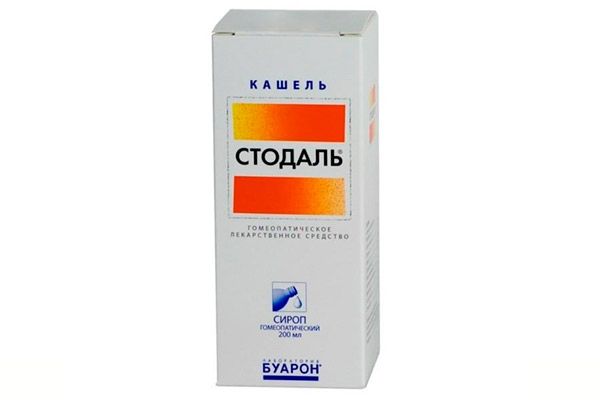
Contraindications for use. The drug is not prescribed if there is intolerance to at least one of the components of the device, including fructose.
The drug should be prescribed with caution during pregnancy and lactation (contains ethanol), as well as in the treatment of patients with diabetes mellitus (contains sugar).
Side effects and cases of overdose have not been reported to date.
Method of administration and dosage. The drug is approved for use in newborns and the elderly.
Children are given the medicine in a dosage of 5 ml. Adult dosage is 15 ml per dose.
The syrup should be taken 3 to 5 times a day. The effect should be noticeable on the third day, but if it is not there even after a week, the drug is discontinued.
Interaction with other drugs. As a homeopathic remedy, Stodal does not enter into dangerous reactions with other drugs. It can be included in complex therapy.
Storage conditions and shelf life. The drug can be stored at room temperature for 5 years.
Reviews: A relatively inexpensive and effective homeopathic preparation, but in the case of a severe cough, the effect is insufficient. I don't like the long treatment period.
Some medications that do not mention cough in their labeling may nevertheless have a positive effect on a patient with a non-productive cough.
Erespal
This drug is not considered a cough medicine in the literal sense of the word, although it helps fight it. What kind of cough does Erespal help with: dry or wet? It is prescribed regardless of whether the cough is accompanied by sputum or not.
Pharmacodynamics. The active substance of the drug is fenspiride. The main effects of the drug are to relieve inflammation, reduce the production of inflammatory exudate, and prevent obstruction of the airways. The drug does not increase the production of sputum, which can be useful for dry cough, which is a residual phenomenon of colds, bronchial asthma and chronic bronchitis, and allergic diseases.
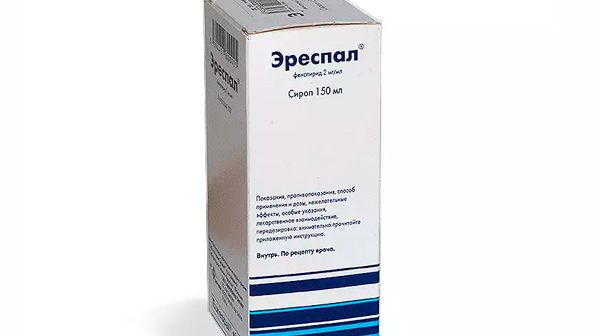
Contraindications for use. Do not use in case of hypersensitivity to the components of the drug.
There is no information about the effect of fenspiride on the fetus, so it is not advisable to use it during pregnancy. Breastfeeding should be discontinued during treatment with the drug.
Side effects. Taking the medicine may be accompanied by nausea and vomiting, pain and heaviness in the epigastrium, drowsiness, a slight increase in heart rate, allergic reactions, including angioedema.
Method of administration and dosage. The drug has 2 forms of release: syrup and tablets. Which should be taken before meals.
Patients over 14 years of age are prescribed the medicine in the form of tablets (1 tablet twice a day) or syrup (3 to 6 tablespoons per day).
For children under 14, Erespal syrup is mainly indicated for dry cough. Infants weighing up to 10 kg are given syrup in a dosage of 5-10 ml twice a day. For older children, the single dose is increased to 10-20 ml.
There have been no reports of overdose or dangerous drug interactions.
Storage conditions and shelf life. Erespal tablets retain their properties at room temperature for 2 years, syrup – 3 years.
Reviews: Reviews of the drug are that it helps with cough, but does not actively secrete phlegm. However, as an anti-inflammatory drug, Erespal has proven itself well. People do not like the price and taste (especially the aftertaste) of the drug. Some complain about the severe side effects of the drug.
 [ 17 ]
[ 17 ]
Antibiotics for dry cough
Antibiotic therapy is an important part of the treatment of infectious and inflammatory cold pathologies. The doctor can prescribe antibacterial drugs for tonsillitis, bronchitis, laryngitis and any other pathology in which a person suffers from a dry or wet cough. Usually, the prescription is made at the beginning of the disease, when the cough is not yet accompanied by abundant sputum.
Antimicrobial agents are prescribed depending on the pathogen. But since the disease is easier to treat if it is caught at the very beginning, and it takes time to identify the pathogen, doctors prefer to resort to broad-spectrum antibiotics. Most often, penicillin and cephalosporin drugs are prescribed (Amoxicillin, Augmentin, Amoxiclav, Amoxil, Flemoxin Solutab, Ceftriaxone), as well as macrolides (most often Summamed).
Antibiotics for dry cough in adults can be prescribed in various forms: tablets, syrups, injection solutions and powders for their preparation. Antibiotics for dry cough in children are best prescribed in the form of syrups and suspensions, and in severe cases - injection solutions.
But it is important to understand that a non-productive cough is only a symptom of a pathology that is treated not so much with antibiotics as with special remedies for dry cough. In addition, prescribing antibiotics with their multiple side effects is not always justified (for example, in allergic or viral pathologies, smoker's cough).
It is important to understand that antibiotics, while helping the body fight infection, at the same time kill the body's natural immunity and beneficial microflora, thereby weakening it. So, without special need, you should not get carried away with such drugs.
The body itself tries to get rid of the infectious factor with the help of the same cough. Antibiotics should only inactivate the infection, not allow it to multiply, but remedies for dry cough will help remove pathogenic bacteria from the body with phlegm, ensuring a quick recovery.
Folk remedies for dry cough
A dry cough can have various causes, so its treatment should be started only after the cause is known. The diagnosis should be made by a specialist doctor who will prescribe effective treatment. Most often, doctors prescribe pharmacy drugs, among which there are quite safe herbal medicines. But if there is no opportunity to get to the pharmacy, then proven folk recipes will come to the rescue.
Folk remedies for dry cough:
- Radish with honey is perhaps the most popular folk remedy for cough. Make a hole in a large black radish and fill it with honey overnight. In the morning, the medicine can be taken 1 spoon up to 4 times a day.
- Ginger, lemon and honey. Grate the peeled ginger root and squeeze out the juice. Add the same amount of lemon juice and half as much honey to a teaspoon of ginger juice. Take the mixture 1 teaspoon every 30 minutes, holding it in your mouth for a while.
- Garlic, honey and vodka – this is already a medicine for adults. Grind 2 cloves of garlic and mix with a tablespoon of honey and two tablespoons of vodka. Infuse. Take 1 teaspoon twice a day, then take a day off and repeat the treatment.
Herbs with expectorant, mucolytic and anti-inflammatory effects also help with dry coughs: licorice, marshmallow, thermopsis, as well as calendula, coltsfoot, wild rosemary, St. John's wort, oregano and others.
Adults can be given herbs for dry cough in the form of decoctions and infusions. It is useful to prepare drinks not with one herb, but with several. For example, mix licorice root, oregano, thyme and chamomile. Such a decoction will have an expectorant and anti-inflammatory effect. You can also use a ready-made pharmacy herbal collection for dry cough.
Herbs for dry cough for children will be the safest medicine. But small patients are very reluctant to drink bitter decoctions and infusions. It is best to try to make healthy treats from them - lollipops. That is, add sugar to the finished herbal decoction and boil it until a drop of the composition will stick together in water and fall to the bottom of the dish.
Another popular folk remedy for dry cough is homemade milk, which helps to cope with dry "barking" cough better than many medicines. Milk-based drinks help to thin phlegm and remove it from the respiratory tract, have a calming effect on the mucous membrane of the throat, and give the body the strength to fight the disease.
Milk-based medicines are suitable for both children and adults, if they do not have an intolerance reaction to the products used. In pediatrics, recipes based on cow's and goat's milk are prescribed to children over 3 years old. But if milk was present in the baby's diet before, such recipes will also suit him.
Most often, milk with honey is used for dry cough. For a glass of milk, you need to take only 1 teaspoon of honey. Drink it warm in 1-2 doses.
It is better to use linden or buckwheat honey. The milk should not be hot, because this can negate the benefits of honey.
It is recommended to add a piece of butter to the described recipe, which will enhance the effect of the tasty medicine. Drink 3-4 times a day, warm.
To make the recipe more enjoyable for children, add half a banana, crushed in a blender, to the milk and honey.
Milk with soda also helps very well with a painful dry cough, because soda helps to quickly and gently liquefy mucus, and milk helps to remove it and relieves inflammation. In this case, you need to take 1/3 teaspoon of soda per glass of milk. The medicine should be drunk immediately.
This recipe should be used before meals 2 times a day.
There are still a lot of different milk-based remedies for dry cough, but this is a topic for a separate article.
Dry cough remedies in the 1st, 2nd, 3rd trimester of pregnancy
Probably, it is the expectant mothers who are the hardest to get sick, because they are responsible for the health of the baby. Not treating the disease is dangerous for both, but the treatment is complicated by the fact that not every medicine is suitable for use during pregnancy.
Herbal treatment during this period seems to be the most acceptable, but it is important to understand that some herbs can negatively affect the course of pregnancy, for example, by causing uterine contractions. So popular antitussive herbs: marshmallow, licorice, thyme and thermopsis are not suitable for women in a delicate position and nursing mothers. So in any case, you cannot do without consulting a doctor.
Moreover, using herbs as the basis for treatment does not always work, and again one has to turn to pharmaceutical drugs.
Pharmaceutical remedies for dry cough have different effects on the body of the expectant mother and her unborn baby. Thus, the drugs "Sinekod", "Omnitus", "Stoptussin", "Ambroxol", "Lazolvan", "Bromhexidine" and "Fluditec" are allowed to be prescribed already from the second trimester of pregnancy.
But the syrup "Doctor MOM" will help the expectant mother to cope with the disease even in the early stages of pregnancy. Folk recipes based on milk, which are also safe during such an important period, will also help him.
Physiotherapy for dry cough at home
One of the safest and most effective methods of treating dry cough is considered to be thermal procedures (warming rubs and compresses), as well as inhalations, which doctors recommend using a nebulizer.
Warming compresses on the chest and back are very helpful for dry coughs, irritating the sensitive receptors responsible for the removal of phlegm, thinning the mucus that accumulates in the bronchi and providing a calming effect on painful unproductive coughs accompanied by pain in the throat and head.
Compresses should be applied for at least 4-5 hours, which means it is better to do this at night. Compresses should be applied correctly. First, natural fabric soaked in a medicinal composition is placed on the skin, then it is covered with polyethylene film or compress paper and insulated with woolen fabric on top.
A safe compress made from boiled potatoes in their skins is good for children and adults. The potatoes are mashed and made into two flat cakes, which are placed hot on the patient's chest and back, previously covered with linen or cotton fabric. A film and insulation are placed on top. When the compress cools down a little, the fabric between the body and the potato cake is removed and the potato is left until it cools down.
A compress with honey and vodka is made differently. First, the patient's body is well lubricated with liquid honey, then it is covered with a cloth soaked in warm vodka (for children, 1 part vodka is mixed with 3 parts water), a film and insulation are placed on top. This composition can be kept even until the morning, however, as is another compress, which is suitable for both small children and their parents.
Natural fabric is folded several times, soaked in warm vegetable oil, and then placed on the patient’s chest and back, covered with film and warm fabric on top.
After the compress is removed, it is recommended to lie in a warm place for a couple more hours so that the body at the site of the compress acquires a normal temperature.
Another very fast and relatively safe way to deal with a dry cough is inhalation. A nebulizer will help to carry out this procedure as effectively as possible, and there will be no trace of the dry cough. It will be replaced by a productive wet cough, which is a harbinger of a speedy recovery.
Using a nebulizer allows you to avoid the negative impact of drugs on the gastrointestinal mucosa. At the same time, drug particles can penetrate deep into the respiratory tract, exerting their specific effect there. The air will not be very hot, as with steam inhalations, which means that such treatment is perfect for children.
According to the rules, inhalations are first carried out with bronchodilators, and then with expectorants and mucolytics. Some drugs (Ambroxol, Lazolvan, Bromhexine) even have a special form of release in the form of an inhalation solution, which is recommended to be mixed with saline or mineral water, which in itself is an effective inhalation agent.
For example, small children may be prescribed 1-2 inhalations of Ambroxol per day, using 1 ampoule (2 ml) of the drug mixed with the same amount of saline solution.
In the case of Lazolvan, children under 2 years of age may be prescribed a solution in the amount of 1 ml, children under 6 years of age use 1 ampoule (2 ml), older children use 2 to 3 ml of inhalation solution for inhalation.
"Bromhexidine" inhalations are carried out 2 times a day, using 2 ampoules of 2 ml for patients over 10 years old, 1 ampoule of pharmacy solution for inhalations for children over 6 years old, 10 drops of the drug for children 2-6 years old, and 5 drops of the solution for newborns and children under 2 years old.
Using various remedies for dry cough that help in the treatment of the underlying disease, we must not forget that cough is only one of the symptoms of the disease, which requires a comprehensive approach to treatment. Only in this case will it be possible to defeat the disease and prevent the transition of cough to a chronic form, in which it will be necessary to treat it for almost the rest of your life at the slightest exacerbation of the disease.
Attention!
To simplify the perception of information, this instruction for use of the drug "Remedies for dry cough" translated and presented in a special form on the basis of the official instructions for medical use of the drug. Before use read the annotation that came directly to medicines.
Description provided for informational purposes and is not a guide to self-healing. The need for this drug, the purpose of the treatment regimen, methods and dose of the drug is determined solely by the attending physician. Self-medication is dangerous for your health.

